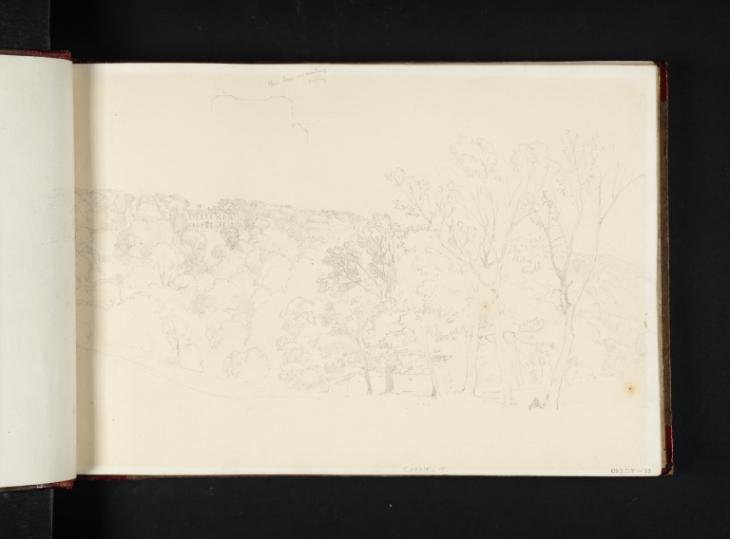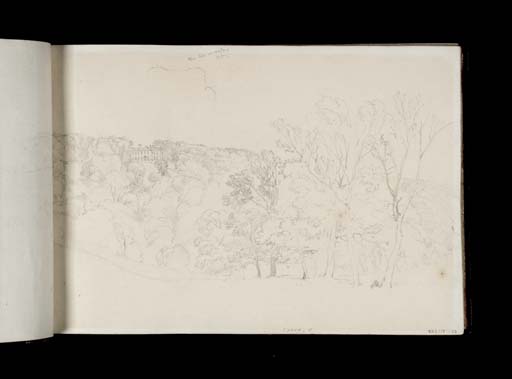Joseph Mallord William Turner Gledhow Hall, Leeds 1816
Image 1 of 2
Joseph Mallord William Turner,
Gledhow Hall, Leeds
1816
Joseph Mallord William Turner 1775–1851
Folio 3 Recto:
Gledhow Hall, Leeds 1816
D09805
Turner Bequest CXXXIV 15
Turner Bequest CXXXIV 15
Pencil on white wove paper with gilt edges, 179 x 254 mm
Inscribed by Turner in pencil ‘open B[...] over windows | r[...]ing’ above plan at top centre
Inscribed in pencil ‘CXXXIV – 15’ bottom centre
Blind-stamped with Turner Bequest monogram bottom right
Stamped in black ‘CXXXIV – 15’ bottom right
Inscribed by Turner in pencil ‘open B[...] over windows | r[...]ing’ above plan at top centre
Inscribed in pencil ‘CXXXIV – 15’ bottom centre
Blind-stamped with Turner Bequest monogram bottom right
Stamped in black ‘CXXXIV – 15’ bottom right
Accepted by the nation as part of the Turner Bequest 1856
Exhibition history
1869
First Loan Collection selected from the Turner Bequest, various venues and dates, 1869–1931 (no catalogue but numbered 7, as ‘Landscape’).
References
1909
A.J. Finberg, A Complete Inventory of the Drawings of the Turner Bequest, London 1909, vol.I, p.381, CXXXIV 15, as ‘A house seen among trees on a hill.’.
1974
Gerald Wilkinson, The Sketches of Turner, R.A. 1802–20: Genius of the Romantic, London 1974, reproduced p.147.
1980
David Hill, Stanley Warburton, Mary Tussey and others, Turner in Yorkshire, exhibition catalogue, York City Art Gallery 1980, p.77 under no.113, as a Gledhow subject, ‘probably ... 1814 or 1815’.
1982
Stanley Warburton, Turner and Dr. Whitaker, exhibition catalogue, Towneley Hall Art Gallery & Museums, Burnley 1982, p.38 under nos.39 and 40, as 1814 or 1815.
1990
Eric Shanes, Turner’s England 1810–38, London 1990, pp.77 under no.53, 283 note 44.
1991
Ian Warrell, ‘R.N. Wornum and the First Three Loan Collections: A History of the Early Display of the Turner Bequest Outside London’, Turner Studies, vol.11, no.1, Summer 1991, pp.39 (venues), 40 no.7, as ‘Landscape (Lead pencil), noting the Gledhow identification.
2008
David Hill, Turner and Leeds: Image of Industry, Leeds 2008, p.99, ill.87 (colour).
Gledhow Hall still stands between Gledhow Lane and Gledhow Wood Close, in a wooded valley between Chapell Allerton and Roundhay on the north side of Leeds, three miles north of the centre of the city;1 it is now divided into apartments and largely surrounded by flats and garages.2 At the time of Turner’s visit it was the home of John Dixon, a successful local merchant,3 whose sister was the sister-in-law of Turner’s friend and major Yorkshire patron, Walter Fawkes4 (see the Introductions to this sketchbook and the overall grouping). David Hill has suggested that Turner may have stayed at the house while drawing in the area.5
Dixon commissioned a watercolour of the house.6 Eric Shanes has noted the present sketch in connection with the finished composition, Gledhow, of 1816 (private collection),7 which was engraved and published in 1820 with a supplement to Dr Thomas Dunham Whitaker’s 1816 history of Leeds, Loidis and Elmete8 (again, see the Introductions to this sketchbook and the overall grouping); it had been listed as plate 9 of the main 1816 volume.9 Of the children gathering sticks which were introduced into the design, Hill has observed that ‘the Dixons presumably approved of their inclusion since they paid for the publication of the plate’10 although such foraging for food and fuel was punished by many landowners through the courts.11
Turner’s viewpoint here is east-north-east across the valley from the Chapell Allerton side. The trees in the sketch are continued just a little to the left on folio 2 verso opposite (D40881; Turner Bequest CXXXIV 13 verso). The direct source for the watercolour was the drawing on folios 3 verso–4 recto (D09806, D09857; Turner Bequest CXXXIV 15v–58). David Hill suggests the current view is the first sketch in the sequence;12 there is a further study on folios 4 verso–5 recto (D09858, D09801; Turner Bequest CXXXIV 58a, 12), the sketches having been brought together when the sketchbook was rebound, despite their widely varying numbering (see the sketchbook’s Introduction).
The hose is also seen in the far distance to the north in Turner’s panoramic drawing of Leeds from Beeston Hill on folio 48 verso (D09883; Turner Bequest CXXXIV 79).
Technical notes:
The page has darkened all over from prolonged display, except for a narrow border protected by the mount.
Matthew Imms
July 2014
How to cite
Matthew Imms, ‘Gledhow Hall, Leeds 1816 by Joseph Mallord William Turner’, catalogue entry, July 2014, in David Blayney Brown (ed.), J.M.W. Turner: Sketchbooks, Drawings and Watercolours, Tate Research Publication, September 2014, https://www


